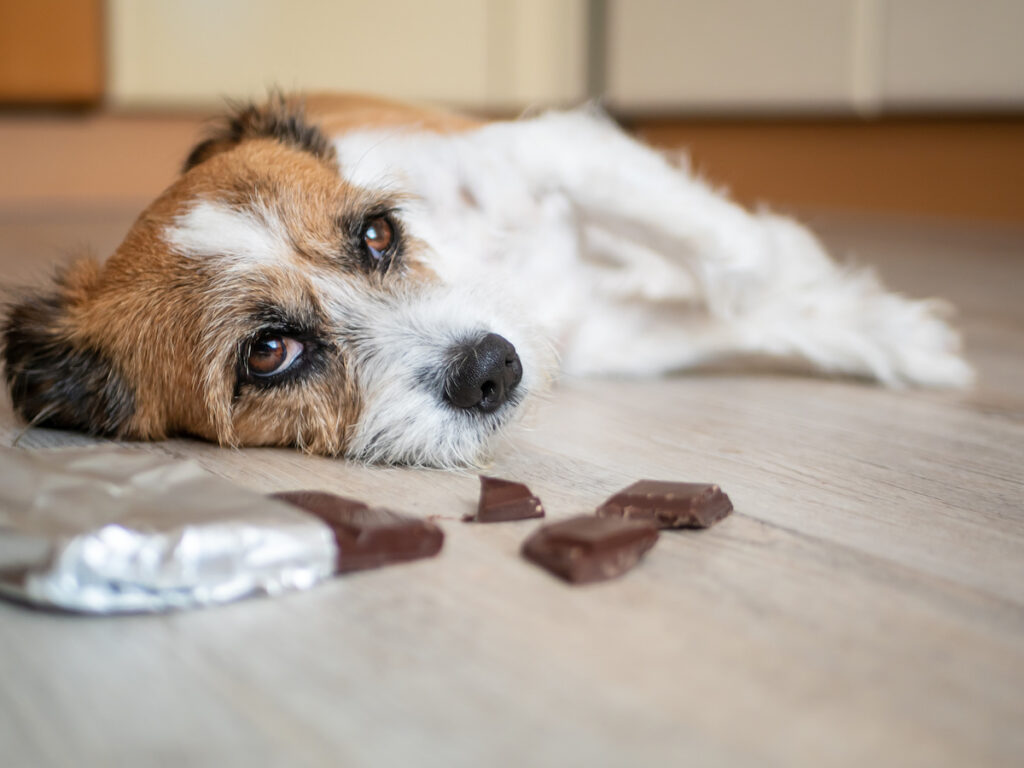With Easter just around the corner I thought now was a good time to remind you all about how dangerous chocolate is for dog’s. Chances are you have heard that chocolate can kill dog’s and it’s not just an old wives tale, it is a fact! But why is chocolate so dangerous for dog’s?

What makes chocolate dangerous for dogs?
There are two dangerous compounds in chocolate that are toxic to dog’s and other pets. These are Theobromine and Caffeine, they are both members of the drug class Methylxanines. Theobromine is the most dangerous compound and is found in the cocoa beans that are used to make chocolate. It is easily metabolised by humans but dog’s process it more slowly and it can build up in their system to toxic levels.
How much chocolate is dangerous?
The severity of the chocolate poisoning will depend on the type of chocolate eaten, the amount eaten and the size/weight of the dog. The higher the cocoa content of the chocolate the more dangerous it is. Therefore cocoa powder and cooking chocolate are more dangerous than milk chocolate. A lethal dose of theobromine is said to be between 100-150mg per kilogram of body weight. Dangerous symptoms can occur with just 60mg per kilogram. ABC Science states that in 100 grams of milk chocolate there is 154mg of theobromine. In 100g of semisweet (dark chocolate) there is 528mg of theobromine. In 100g of cooking chocolate there is 1,365mg of theobromine. For an average dog of 20-25kg a dog they would only need to consume about 1.5 kg of milk chocolate, 400 gm of dark chocolate, or 140 gm of cooking chocolate for it to be fatal.
Symptoms of chocolate poisoning
Symptoms of chocolate toxicity in dogs can start anywhere from 4 – 24 hours after ingestion and last for upwards of 72 hours. Signs that your dog may be suffering from chocolate toxicity include;
- Restlessness
- Excitement
- Hyperactivity
- Nervousness
- Vomiting
- Diarrhoea
- Trembling
- Increased drinking
- Increased urination
- Elevated heart rate
- Muscle tremors
- Seizures
- Possible death
If a dog eats chocolate there is a high chance that they have eaten the packaging as well. The foil or paper wrapping can also cause issues such as a blockage or perforation in the stomach or intestines. These conditions may take a few days to develop so keep an eye out for symptoms such as abdominal pain, trouble passing faeces, depression and decreased appetite.
Treatment for chocolate poisoning
The treatment for chocolate poisoning usually involves inducing vomiting if caught in the early stages. This is to try and reduce the amount of theobromine that is able to be absorbed. Activated charcoal may also be fed into the stomach to reduce the absorption. IV fluids may be administered as supportive therapy. The dog will usually be monitored closely for at least 24-48 hours for any changes in heart rate, respiratory rate or seizures.
If you ever know or suspect that your dog has ingested chocolate you should contact your veterinarian immediately. Even if they have only consumed a small amount of chocolate it is always best to contact your vet for advice as initially your dog may seem fine but their condition can deteriorate rapidly.
Chocolate poisoning can occur in cats however it is less common because cats dislike the sweet taste of chocolate.
Although one little Easter egg or a small square of chocolate is unlikely to harm your dog it is always advised that you should never feed your dog any chocolate. Be sure that you and the Easter bunny hide those chocolate eggs well out of reach of your pooch.
Wishing you all a happy and safe Easter.
Until next time,
Bec

Our little rescue rascal Twinkle, a Chi/terrier cross, ate several liqueur chocolates one night, late, while we were driving a friend home. He even managed to unwrap them from the foil first. My husband said wait until morning but I panicked and we drove him to the emergency vet, whereupon he became so stressed that his heart rate went up past 200. The vet said the stress was more likely to kill him than the chocolates, so, $700 poorer, we took him home again and the next day he was fine.
Oh what a cheeky little boy! Thank you for sharing your story and I am so glad that everything was ok.
Thanks so much for the information in regards to chocolate and dogs.
Last week my spoodle consumed a whole dark chocolate tim tam which was a treat for me.
Knowing of the importance of having it removed straight away.Also my knowledge, I was pleased that he could visit the vet as a emergency case.
I have heard of people feeding their dogs chocolate the harm that it must do them
Im glad that your boy was ok after his “treat”. It is definitely best that we don’t share our chocolate with our pets, better to be safe than sorry.
Our two beagles consumed an unknown number of Lindt chocolates [only the best for these two] removed cleverly from a zipped up port [suitcase for those from Victoria!]. We observed the dogs for 7 days and there were no signs of any impact in terms of changes in behaviour. Appetites were much the same. On Day 7 a total of 14 blue and white foil wrappings were brought up!
It seems your beagles were using their very good sniffer noses to find those yummy chocolates. Thank you for sharing your story and I am glad that everything turned out ok.